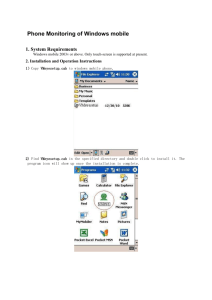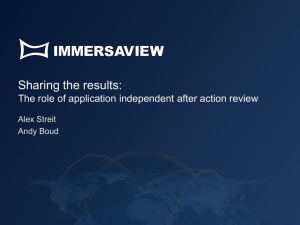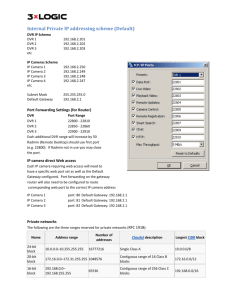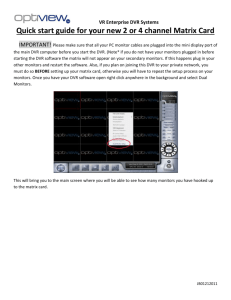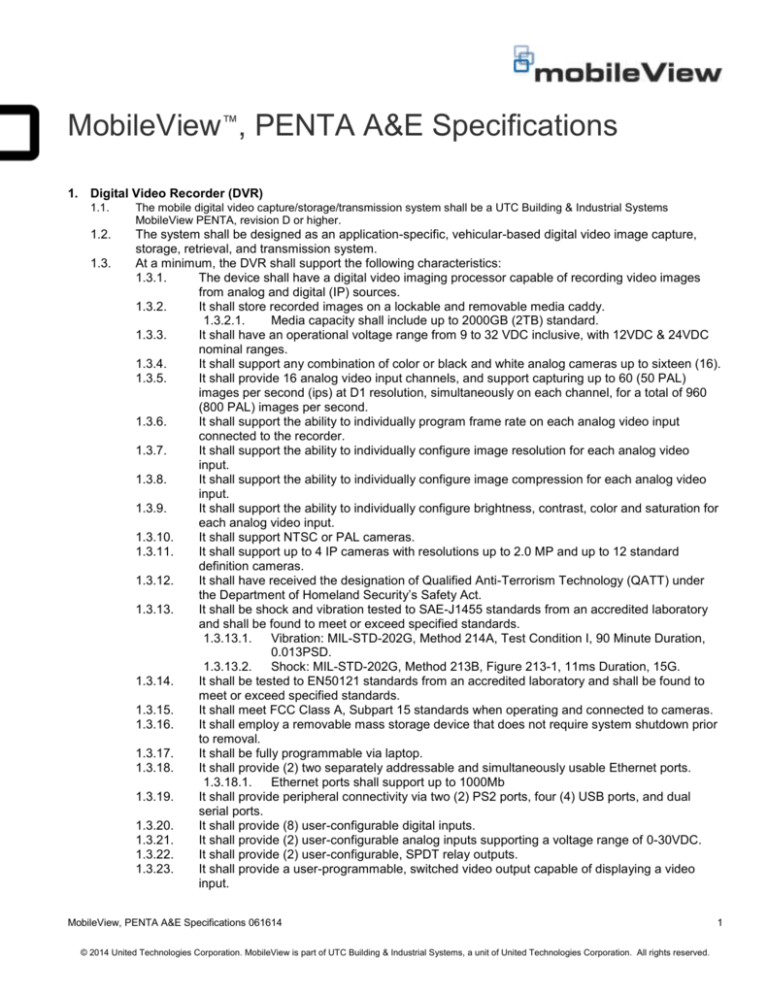
MobileView™, PENTA A&E Specifications
1. Digital Video Recorder (DVR)
1.1.
The mobile digital video capture/storage/transmission system shall be a UTC Building & Industrial Systems
MobileView PENTA, revision D or higher.
1.2.
The system shall be designed as an application-specific, vehicular-based digital video image capture,
storage, retrieval, and transmission system.
At a minimum, the DVR shall support the following characteristics:
1.3.1.
The device shall have a digital video imaging processor capable of recording video images
from analog and digital (IP) sources.
1.3.2.
It shall store recorded images on a lockable and removable media caddy.
1.3.2.1.
Media capacity shall include up to 2000GB (2TB) standard.
1.3.3.
It shall have an operational voltage range from 9 to 32 VDC inclusive, with 12VDC & 24VDC
nominal ranges.
1.3.4.
It shall support any combination of color or black and white analog cameras up to sixteen (16).
1.3.5.
It shall provide 16 analog video input channels, and support capturing up to 60 (50 PAL)
images per second (ips) at D1 resolution, simultaneously on each channel, for a total of 960
(800 PAL) images per second.
1.3.6.
It shall support the ability to individually program frame rate on each analog video input
connected to the recorder.
1.3.7.
It shall support the ability to individually configure image resolution for each analog video
input.
1.3.8.
It shall support the ability to individually configure image compression for each analog video
input.
1.3.9.
It shall support the ability to individually configure brightness, contrast, color and saturation for
each analog video input.
1.3.10.
It shall support NTSC or PAL cameras.
1.3.11.
It shall support up to 4 IP cameras with resolutions up to 2.0 MP and up to 12 standard
definition cameras.
1.3.12.
It shall have received the designation of Qualified Anti-Terrorism Technology (QATT) under
the Department of Homeland Security’s Safety Act.
1.3.13.
It shall be shock and vibration tested to SAE-J1455 standards from an accredited laboratory
and shall be found to meet or exceed specified standards.
1.3.13.1.
Vibration: MIL-STD-202G, Method 214A, Test Condition I, 90 Minute Duration,
0.013PSD.
1.3.13.2.
Shock: MIL-STD-202G, Method 213B, Figure 213-1, 11ms Duration, 15G.
1.3.14.
It shall be tested to EN50121 standards from an accredited laboratory and shall be found to
meet or exceed specified standards.
1.3.15.
It shall meet FCC Class A, Subpart 15 standards when operating and connected to cameras.
1.3.16.
It shall employ a removable mass storage device that does not require system shutdown prior
to removal.
1.3.17.
It shall be fully programmable via laptop.
1.3.18.
It shall provide (2) two separately addressable and simultaneously usable Ethernet ports.
1.3.18.1.
Ethernet ports shall support up to 1000Mb
1.3.19.
It shall provide peripheral connectivity via two (2) PS2 ports, four (4) USB ports, and dual
serial ports.
1.3.20.
It shall provide (8) user-configurable digital inputs.
1.3.21.
It shall provide (2) user-configurable analog inputs supporting a voltage range of 0-30VDC.
1.3.22.
It shall provide (2) user-configurable, SPDT relay outputs.
1.3.23.
It shall provide a user-programmable, switched video output capable of displaying a video
input.
1.3.
MobileView, PENTA A&E Specifications 061614
© 2014 United Technologies Corporation. MobileView is part of UTC Building & Industrial Systems, a unit of United Technologies Corporation. All rights reserved.
1
1.3.24.
1.3.25.
1.4.
1.5.
1.6.
It shall provide connection to external devices via removable screw down terminals.
It shall provide optional connection via wiring harnesses having a positive lock with quick
disconnect function.
The DVR shall operate from a proprietary, embedded system platform with the following features:
1.4.1.
It shall have a firmware embedded operating system. Operating system on rotating magnetic
or optical media shall not be allowed nor considered as equal.
1.4.2.
It shall have an on-board, real-time clock.
1.4.3.
The ability to synchronize the on-board clock from a NTP server or GPS.
1.4.4.
The DVR shall have an on board memory that stores the time, date and all internal
programming functions.
1.4.5.
It shall prevent unauthorized program tampering through the use of a logon account and pass
code.
The DVR shall weigh not more than 12 lbs.
The DVR manufacturer shall provide cameras with the following specification(s) designed for the system,
with the following features as a minimum:
1.6.1.
Cameras housings and screws shall be tamper-resistant and of the following types:
1.6.1.1.
Surface or flush mounted
1.6.1.2.
Forward facing that allows mounting or hanging from the ceiling. It shall include
a rubber lens shield to prevent glare from interior lighting and contact with vehicle
windshield.
1.6.2.
Interior cameras shall supply:
1.6.2.1.
Support options for black & white, color, and wide dynamic range.
1.6.2.2.
Various lens configurations
1.6.2.3.
Optional IR LED’s with auto lighting control
1.6.2.4.
Shall be impact and tamper-resistant and have at least IP 66 rating.
1.6.2.5.
Power supply: 12VDC
1.6.2.6.
Operating temperature range: -10°C to 50°C (14 to 122°F)
1.6.3.
The wide dynamic range camera shall supply:
1.6.3.1.
520 TVL
1.6.3.2.
Dynamic range equal to (102dB typical, 120dB max)
1.6.3.3.
Various lens configurations
1.6.4.
The IP camera shall supply:
1.6.4.1.
2MPx ¼” Progressive Scan CMOS
1.6.4.2.
1600 X 1200 resolution
1.6.4.3.
Dual streams
1.6.4.4.
H.264/MJPEG video compression
1.6.4.5.
Support the following Protocols: TCP/IP, HTTP, DHCP, DNS, DDNS,
RTP/RTSP, PPPoE, SMTP, NTP
1.6.4.6.
Shall provide on-board reset button
1.6.4.7.
Shall be user configured via Ethernet with a personal computer and a current
version of the Internet Explorer web browser
1.6.4.7.1.
Shall have an integrated web client interface to configure,
upgrade and view the following information:
1.6.4.7.1.1.
View live video
1.6.4.7.1.2.
Configure system settings
1.6.4.7.1.3.
Configure camera settings and user settings
1.6.4.7.1.4.
View the system information
1.6.4.7.2.
Admin status shall grant access to all menus
1.6.4.8.
Power supply: PoE (802.3af), 12 VDC
1.6.4.9.
Environmental rating of IP66 (vandal-resistant)
1.6.4.10.
Operating temperature range: -10°C to 60°C (14 to 140°F)
1.6.5.
Externally mounted cameras and cameras with views external to the vehicle shall meet the
following requirements:
1.6.5.1.
Shall be a color day/night camera (automatically switching from color to
black/white via a mechanical cut filter in low-light conditions) with operation down
to at least 0.3 Lux.
1.6.5.2.
Externally mounted cameras shall have a water-proof, sturdy design able to
stand up against the normal external wear and tear of a vehicle due to tree
branches, vehicle washes, etc.
MobileView, PENTA A&E Specifications 061614
© 2014 United Technologies Corporation. MobileView is part of UTC Building & Industrial Systems, a unit of United Technologies Corporation. All rights reserved.
2
1.6.5.3.
1.7.
1.8.
Externally mounted cameras shall be impact and tamper-resistant and have at
least IP 66 rating.
1.6.5.4.
Externally mounted cameras shall have a built-in Infrared Illuminator to enhance
low-light response.
1.6.5.5.
Power supply: 12VDC
1.6.5.6.
Rear camera shall supply the following:
1.6.5.6.1.
650 TVL
1.6.5.6.2.
Sony Enhanced Hi-Res DSP
1.6.5.6.3.
Power Supply: 12 – 48 VDC
1.6.5.6.4.
Operating temperature range: -30°C to 85°C (-22 to 185°F)
1.6.6.
Forward viewing camera shall have a varifocal lens with a range of at least 4– 8 mm.
1.6.7.
Forward viewing camera shall have wide dynamic range to reduce the effects of oncoming
headlights or other lights experienced when operating during night time.
1.6.8.
The recorder shall accept standard NTSC or PAL video signals with 1-volt peak-to-peak signal
at the recorder.
The DVR manufacturer shall make available an optional accelerometer sensor, specifically designed for
the system, with the following features as a minimum:
1.7.1.
The accelerometer sensor shall respond to changes in acceleration on the X-axis, Y-axis, and
Z-axis.
1.7.2.
The accelerometer sensor shall utilize a standard 9-pin serial data interface (relays and digital
or analog voltage level sensors shall not be considered equivalent) specifically designed to
provide the recorder the exact acceleration response in all three axis.
1.7.3.
The accelerometer sensor shall require no separate power connection, and support operation
at distances up to 25’ from the recorder.
1.7.4.
The accelerometer sensor shall be adaptable to flat-surface mounting (typically, the frame of
the vehicle), in order to minimize vibration.
1.7.5.
The recorder shall provide built-in diagnostic and configuration software for the accelerometer
sensor.
1.7.6.
The recorder shall permit event activation if acceleration in any one, two, or three axis
exceeds a user configurable threshold not to exceed 6 g’s.
The DVR manufacturer shall make available an optional remote video transmission system which shall
support the following:
1.8.1.
Transmission of images from the DVR to a central monitoring station
1.8.2.
Bi-directional transmission shall be supported, meaning:
1.8.2.1.
The recorder may automatically send event video to the central station.
1.8.2.2.
The central station may request video information stored locally on the recorder
or live video as determined by the system operator.
1.8.3.
The DVR shall specifically support data and video transmission utilizing wireless technologies
802.11b/g/n and 802.16.
2. Operational Features:
2.1.
The DVR shall support the following recording characteristics:
2.1.1.
The DVR shall continue to function for up to 90 minutes after the ignition has been turned off.
Exact duration shall be user-configurable.
2.1.2.
The DVR shall record surveillance and event video on a removable, mass storage device. No
videotape or videotape recorders shall be used. The DVR shall support at minimum a storage
size of 1000GB on a single mass storage device with an option for 2000GB.
2.1.3.
The DVR shall digitally capture and store images into a self-contained, data file format.
Source information shall be stored and embedded into the video stream to include:
2.1.3.1.
Time and date stamp
2.1.3.2.
Recorder specific information
2.1.3.2.1.
Vehicle identification number
2.1.3.2.2.
Camera identification
2.1.3.2.3.
Speed and heading
2.1.4.
GPS data
2.1.5.
Recording status
2.1.6.
Video signal status (loss of video)
2.1.7.
Image validity
2.1.8.
The DVR shall provide for several record settings.
MobileView, PENTA A&E Specifications 061614
© 2014 United Technologies Corporation. MobileView is part of UTC Building & Industrial Systems, a unit of United Technologies Corporation. All rights reserved.
3
2.1.9.
2.1.10.
2.1.11.
2.2.
2.3.
Capture rate shall be user-configurable between 1 & 30 fps, inclusive NTSC (1 & 25 PAL).
Image resolution shall be user selectable from these settings:
CIF (VGA, NTSC, & PAL)
2.1.11.1.1.
2CIF (VGA, NTSC, & PAL)
2.1.11.1.2.
D1 (VGA, NTSC, & PAL)
2.1.11.2.
Relative image compression shall be user configurable using a sliding scale.
2.1.11.3.
Setting changes shall be viewable within an image preview window.
2.1.12.
The DVR shall support tagging images as associated with an event.
2.1.12.1.
All recorded video and transactional data associated with an event shall be
copied to a separate video storage partition when the event is activated.
Programmed events may be activated from:
2.1.12.1.1.
Digital inputs
2.1.12.1.2.
Analog input thresholds
2.1.12.1.3.
Time of day
2.1.12.1.4.
Speed
2.1.12.1.5.
G-force in 3-axis
2.1.12.1.6.
GPS location
2.1.12.2.
Source video and transactional data shall remain unchanged.
2.1.12.3.
Event activation schedules based on time of day and day of week shall control
whether an event is enabled or disabled.
2.1.12.4.
Automatic purge of transactional alarm and event files after a user-configurable
number of days shall be supported.
2.1.13.
The DVR shall support time, date, and activity logging of routine and critical system events.
2.1.13.1.
The active log shall be closed and locally archived after 24 hours and the next
restart.
2.1.13.2.
Archived data shall be moved to a dedicated and separate log storage area.
Routine and critical activity shall at minimum include:
2.1.13.2.1.
Startup & shutdown action and causes
2.1.13.2.2.
Video archive status
2.1.13.2.3.
Alarm & event actions & reactions
2.1.13.2.4.
Output actions
2.1.13.2.5.
Storage media health
2.1.13.2.6.
System faults and errors
2.1.14.
The DVR shall recognize when available storage capacity is full and automatically purge the
oldest data in sequential fashion (FIFO), making room for additional images without operator
intervention.
2.1.14.1.
Activation of an error condition when FIFO occurs shall be user selectable.
2.1.15.
The DVR shall provide a function to automatically delete archive and log data older than a
user-configurable number of days.
2.1.15.1.
Number of days old shall support integer values up to 90.
2.1.15.2.
Archive deletion days and log deletion days shall be individually configurable.
2.1.15.3.
The function has no effect on FIFO operation.
2.1.15.4.
The function may be turned off.
The DVR shall have optional transmission capabilities.
2.2.1.
The DVR shall support transmission of vehicle specific data upon request by the central
station or other authorized remote user. Such data shall include but not be limited to:
2.2.1.1.
Live video images
2.2.1.2.
Previously recorded images
2.2.1.3.
DVR log information
The DVR shall support the following alarm event functions:
2.3.1.
The DVR shall support user-programmable events that consisting of event activation triggers
and event reaction responses.
2.3.2.
Event activation triggers shall at minimum include:
2.3.2.1.
Digital input state (On/Off)
2.3.2.2.
Analog input level set point (Above/Below)
2.3.2.3.
Acceleration in one or more axis (X, Y, Z)
2.3.2.4.
Distance from a GPS position (Lat., Long., Radius)
2.3.2.5.
Time-based (Day, Time, Duration)
2.3.3.
Event reaction responses shall at minimum include:
MobileView, PENTA A&E Specifications 061614
© 2014 United Technologies Corporation. MobileView is part of UTC Building & Industrial Systems, a unit of United Technologies Corporation. All rights reserved.
4
2.4.
2.5.
2.6.
2.3.3.1.
Change state of digital output
2.3.3.2.
Switch video input to multiplexed video output
2.3.3.3.
Play an audio file
2.3.3.4.
Record an event based video archive
2.3.3.5.
Start recording a video input
2.3.3.6.
Start recording an audio input
2.3.3.7.
Change video channel frame rate
2.3.3.8.
Shutdown the recorder
2.3.4.
The event based video archival function shall support user-programmable pre-event and postevent settings up to 10 minutes. Each event-based archival video event shall be stored in
separate a file with a unique file name based upon activation time, date, and input.
2.3.5.
When selected, record video and record audio event reactions shall be active only during
archival of a video event.
The DVR shall support the following central station capabilities:
2.4.1.
The DVR shall support Wi-Fi 802.11b/g/n, Wi-Max 802.16, Cellular 3G/LTE wireless network
links to a central station.
2.4.2.
At a minimum, the operator shall be able to do the following with the images transmitted to the
central station for viewing:
2.4.2.1.
View current log file
2.4.2.2.
View images
2.4.2.3.
Store images
2.4.2.4.
Increase or decrease playback speed
2.4.2.5.
Search for a specific image by Time & Date
2.4.3.
Captured images shall be downloaded from the DVR onto a computer with central station
compatible software installed, as follows:
2.4.3.1.
The DVR shall to connect to the central station through a wireless network link.
2.4.3.1.1.
Via that link, images may be viewed or stored at the central
station
2.4.3.2.
The DVR removable HDD caddy may be inserted into a docking station
connected to central station via a standard USB 2.0 link.
2.4.3.2.1.
Via that link, images may be viewed or stored at the central
station
2.4.3.3.
Images stored on the central station may be transferred to long-term storage,
including but not limited to the following:
2.4.3.3.1.
DAT tapes
2.4.3.3.2.
CDR/CDRW
2.4.3.3.3.
DVDR/DVDRW
2.4.4.
Image playback shall have the following capabilities at a minimum:
2.4.4.1.
Image playback at positive or negative integer multipliers of normal speeds, in
either forward or reverse modes, without distortion.
2.4.4.2.
Media search capabilities for archiving, restoring and playback operations,
including but not limited to:
2.4.4.2.1.
Start/stop time filters
2.4.4.2.2.
Start/stop date filters
2.4.4.2.3.
Image tags or bookmarks
The DVR shall support the following programming capabilities:
2.5.1.
Display options
2.5.1.1.
Vehicle identification
2.5.1.2.
Camera identification
2.5.1.3.
Time and date
2.5.1.4.
GPS data
2.5.1.5.
Speed and heading
2.5.1.6.
Record status
The DVR shall support the following alarm capabilities:
2.6.1.
The DVR shall support eight optically isolated digital inputs and 2 analog voltage inputs.
Inputs may be associated with events to perform actions such as:
2.6.1.1.
Initiate event-based recording (copying a section of video to an archival location)
2.6.1.2.
Increase capture rate of system cameras to a specified value
2.6.1.3.
Activation of an output relay
MobileView, PENTA A&E Specifications 061614
© 2014 United Technologies Corporation. MobileView is part of UTC Building & Industrial Systems, a unit of United Technologies Corporation. All rights reserved.
5
2.7.
2.8.
2.9.
2.6.1.4.
Automatic system shutdown
The DVR shall support Ethernet communications.
2.7.1.
The DVR shall not stop recording during Ethernet access.
2.7.2.
The DVR shall allow the user full programming of Ethernet parameters, including:
2.7.2.1.
IP addressing
2.7.2.2.
Default gateway
2.7.2.3.
Sub-net mask
The DVR shall support the following time synchronization capabilities:
2.8.1.
Synchronization via GPS (if so equipped)
2.8.2.
Synchronization via common network time source (time server)
The DVR shall support networking standards including but not limited to:
2.9.1.
DHCP
2.9.2.
DNS & WINS
2.9.3.
VPN
3. Additional specifications:
3.1.
Camera inputs
3.1.1.
There shall be eight (8) camera inputs equipped with BNC connectors.
3.1.2.
There shall be an option for sixteen (16) camera inputs equipped with BNC connectors.
3.1.3.
Inputs shall be NTSC or PAL compatible.
3.1.4.
All inputs shall have AGC (automatic gain control).
3.1.5.
Inputs shall accept video levels from 0.7 to 1.0 volts peak-to-peak.
3.2.
The DVR shall support audio recording with the following capabilities:
3.2.1.
Audio recording shall be 2 X mono (or 1 X stereo).
3.2.2.
Audio output shall be 2 X mono (or 1 X stereo).
3.2.3.
Audio shall be synchronized with the video.
3.3.
The DVR shall incorporate the following electrical specifications:
3.3.1.
Input voltages to be supported: 9 to 32 VDC inclusive, with 12VDC and 24VDC nominal.
3.3.2.
It shall be self-regulating and internally protected from power surges and spikes.
3.3.3.
Operating power: 75 W nominal, excluding externally-connected devices
3.4.
The DVR shall incorporate the following mechanical specifications:
3.4.1.
Size: 11.5” x 7.25” x 7.25" (W x D x H)
3.5.
The DVR shall incorporate the following environmental specifications:
3.5.1.
Operating temperature 0 to 50 °C (external ambient)
3.5.2.
Relative humidity: 90% non-condensing
4. CCTV Video Review Application:
4.1.
The software shall be backward compatible with all current hardware versions of the MobileView 4 and
MobileView PENTA systems.
4.2.
Video review software shall provide basic functionality including but not limited to play forward, pause &
play backwards, play with synchronized audio, move forward frame by frame, move backward frame, fast
forward and reverse – speed up - 2x, 4x, 8x, 16x, 32x, 64x, 128x, 256x, 512x, 1024x.
4.3.
The software shall enable the user to save a series of JPEG or BMP images to a sub-directory.
4.4.
The software shall enable the user to save a selected video clip to a standards based format such as AVI
for playback using a standards-based media player.
4.5.
The software shall allow recorded images to be displayed at the configured screen resolution. Images
will be digitally scaled to fit the selected screen display area.
4.6.
The software shall allow time and date searches of recorded information.
4.7.
The software shall allow time and date searches showing GPS indicator and Speed indicator.
4.8.
The software shall allow time and date searches showing Digital Input activations.
4.9.
The software shall allow the user to select video playback from a specific geographic point provided GPS
data has been encoded with the video stream
4.10. The software shall permit incident location via time search by direct entry into a time/date field or via
drag/drop of a time line bar.
4.11. The software shall support Sound Equalizer allowing pre-processing of the audio playback to
accentuate/deaccentuate various audio frequency bands.
4.11.1.
The software shall support sound equalizer in the following bands: 250Hz, 1.5KHz and 4KHz.
4.12. The software call support Automatic Reconnections between the playback device and the source of the
playback.
MobileView, PENTA A&E Specifications 061614
© 2014 United Technologies Corporation. MobileView is part of UTC Building & Industrial Systems, a unit of United Technologies Corporation. All rights reserved.
6
4.13.
5. GPS
5.1.
5.2.
5.3.
5.4.
5.5.
5.6.
The software shall support exporting and saving of files to a variety of different media types:
4.13.1.
Single frame export will be supported
4.13.2.
Export of multiple frames between a times will be supported
4.13.3.
Output to AVI will be supported
4.13.4.
Automatic CD/DVD video archive creation
4.13.5.
Print a single camera frame
4.13.6.
Print a single map view
GPS function shall support minimum of 16 tracking channels
GPS velocity accuracy shall be 0.1m/sec
GPS polling and update shall occur at 1pps, minimum
GPS frequency shall be L1, 1575.42Mhz
GPS information recorded will be latitude, longitude and speed
GPS information display shall be overlaid upon a map window
5.6.1.
GPS coordinate data shall be synchronized to recorded video
5.6.2.
Map overlay shall support raster image formats
6. Garage Management Application Extensions
6.1.
The DVR shall provide facilities for seamless integration with a garage management system.
6.2.
The DVR shall, upon connection to the local or extended wireless network, support garage management
video functions including but not limited to:
6.2.1.
“Last-Mile-Access” – Initiate automated functions
6.2.2.
“Auto-Upload” – Automated upload of event-based video stored on DVR
6.2.3.
“Clip Find” - Automated video data retrieval based on user defined parameters such as:
6.2.3.1.
Vehicle identification
6.2.3.2.
Time and date in From/To format
6.2.3.3.
Frames per second filters
6.2.3.4.
Video channel filters
6.2.4.
“Live Look-in” – Continuous live video and audio (if equipped) playback from recorder for
investigation of current on-vehicle situations.
6.3.
The DVR shall support garage management reporting functions:
6.3.1.
Email delivery to confirm success or failure of automated download events.
6.3.2.
Download statistics including but not limited to:
6.3.2.1.
Average transmission throughput
6.3.2.2.
Transmission file size
6.3.2.3.
Transmission start/stop times
6.3.3.
Transmission and storage of daily DVR activity and operating logs.
6.3.4.
DVR heath and status statistics:
6.3.4.1.
Critical component temperature levels
6.3.4.2.
Input and output voltage levels
6.3.4.3.
Cooling fan status
6.3.4.4.
Fuse status
6.3.5.
Camera image check
6.3.6.
Voltage levels
6.4.
The DVR shall support garage management control functions including but not limited to:
6.4.1.
Auto-synchronization of recorder time clocks from a network time server.
6.4.2.
Automated update of recorder configuration, software, and firmware from a central network
location.
6.5.
The DVR shall support garage management GPS extensions including but not limited to:
6.5.1.
Video data search using GPS location information
6.5.2.
Vehicle location display on area map using current and last known location information
7. Heavy-Duty Vehicle Interface (Optional)
7.1.
The DVR shall provide optional support of heavy-duty vehicle interface
7.1.1.
J1708
7.1.2.
J1587
7.2.
The DVR shall support fault reporting via the heavy-duty vehicle interface with specific reporting items:
7.2.1.
Generic Fault
MobileView, PENTA A&E Specifications 061614
© 2014 United Technologies Corporation. MobileView is part of UTC Building & Industrial Systems, a unit of United Technologies Corporation. All rights reserved.
7
7.3.
7.2.2.
Power Fault
7.2.3.
Thermal Fault
7.2.4.
Camera Fault
The DVR shall allow support of both the optional heavy-duty vehicle interface and accelerometer on the
same system.
8. General Conditions
8.1.
Company References
8.1.1.
Vendor shall have at a minimum of five years’ experience installing, servicing and selling a
transit version recorder in the public transit market.
8.1.2.
Vendor shall have (and submit a list) in excess 50 transit customers in North America.
8.1.3.
Vendor shall be able to service or upgrade all existing versions of recorders currently
employed in the field.
8.1.4.
Vendor shall provide a customer reference list of at least 10 transit customers currently using
the systems in transit applications.
8.1.5.
Vendor shall have at least 18,000 working (in good order) units installed and in service in
North America.
9. Experience in Wireless Applications
9.1.
Vendor shall have at least (3) Wireless projects operational in North America. (Project defined as at least
50-100 vehicles (minimum) in a fleet sending and receiving commands and/or video information).
9.2.
Vendor shall have experience to lead the design and deployment of advanced integrated networks
supporting high-capacity data downloads and low-latency data streams across a mix of Cellular, Wi-Fi,
WiMAX and similar mesh technologies.
9.3.
Vendor shall be able to design and implement Wired and Wireless networks to support Mobile CCTV
uploads. These designs should be able to integrate into the following:
9.3.1.
Existing customer Domain Networks
9.3.2.
Standalone Extension
9.3.3.
Virtual and physical server environments
9.3.4.
Integrating management system into corporate Wi-Fi networks and group policies
9.4.
Vendor shall have experience accommodating different physical deployment options including but not
limited to:
9.4.1.
Fuel Lanes
9.4.2.
Indoor Vehicle Locations
9.4.3.
Outdoor Vehicle Locations
9.4.4.
Rail Yards (Heavy/Light Rail)
9.4.5.
Bus Yards
9.5.
Vendor shall have experience installing, integrating and troubleshooting simple and complex corporate
network infrastructures.
9.6.
Vendor shall have experience transmitting live video over cellular and vehicle Wi-Fi hotspots.
MobileView, PENTA A&E Specifications 061614
© 2014 United Technologies Corporation. MobileView is part of UTC Building & Industrial Systems, a unit of United Technologies Corporation. All rights reserved.
8

